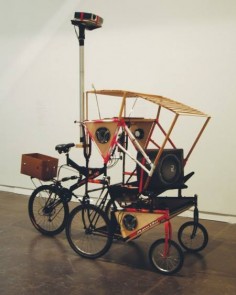ABRAHAM CRUZVILLEGAS
A. C. Mobile
source: artdiscover
Abraham Cruzvillegas studied Philosophy and Art at the National Autonomous University of Mexico (UNAM). He later became a professor and went on to teach Art History and Theory at UNAM.
As a sculptor and writer, Cruzvillegas began as a central participant in a new wave of conceptual art in Mexico City during the late 1980s and 90s, studying under Gabriel Orozco from 1987 to 1991.
Along with Orozco, Damian Ortega, Dr Lakra, and Minerva Cuevas, Cruzvillegas was considered part of a new movement in Latin American art (which has been compared to the YBA boom in Britain in the 1980s). His work is held in the collections of Tate Modern, London and MoMA, New York.
Cruzvillegas has shown his work in single and group exhibitions in a number of galleries across Europe, South America and the United States.
In 1994, his work was shown in the Fifth Havana Biennial; in 2002 in the XXV São Paulo Biennial; in 2003 in the Fiftieth Venice Biennale; in 2005 in the 1st Torino Triennale; in 2008 in the Bienal de Cali, in Colombia; in the Tenth Havana Biennial, and the Seventh Bienal do Mercosul in Portoalegre. His work has been shown at the New Museum, New York and at Tate Modern in London. Cruzvillegas participated in ROUNDTABLE: The 9th Gwangju Biennale, which takes place September 7 – November 11, 2012 in Gwangju, Korea.
In August 2012, it was announced that Cruzvillegas had won the Fifth Annual Yanghyun Prize.
He is also the co-author of two books in collaboration with the Mexican artist Dr Lakra.
.
.
.
.
.
.
.
source: artspace
Abraham Cruzvillegas is one of the most notable conceptual artists of his generation to come out of the vibrant art scene in Mexico. Over the past 10 years, Cruzvillegas has developed a riveting body of work that investigates what he calls “autoconstrucción,” or self-construction.
Informed by the sociopolitical context of Latin America, Cruzvillegas has garnered attention for his dynamic assemblage sculptures made of found objects. Interested in improvised building materials and techniques, he roots his sculptural practice within the urban landscape of his childhood home in Ajusco, a district in the south of Mexico City. To this day, Ajusco’s landscape of volcanic rock remains a work in process: structures are in a constant state of transformation, with additions made according to the dictates of necessity and the availability of materials. This way of constructing has become the basis of Cruzvillegas’s own thinking and methodology, while operating as a rich metaphor for the articulation of individual identity and place.
Featuring 30 to 35 individual sculptures and installations, along with his recent experiments in video, film, and performance, Abraham Cruzvillegas: The Autoconstrucción Suites at the Walker Art Center in Minneapolis is the first major museum exhibition to shed light on the artist’s unique vision and multifaceted practice.
Cruzvillegas is represented by Kurimanzutto in Mexico City.


